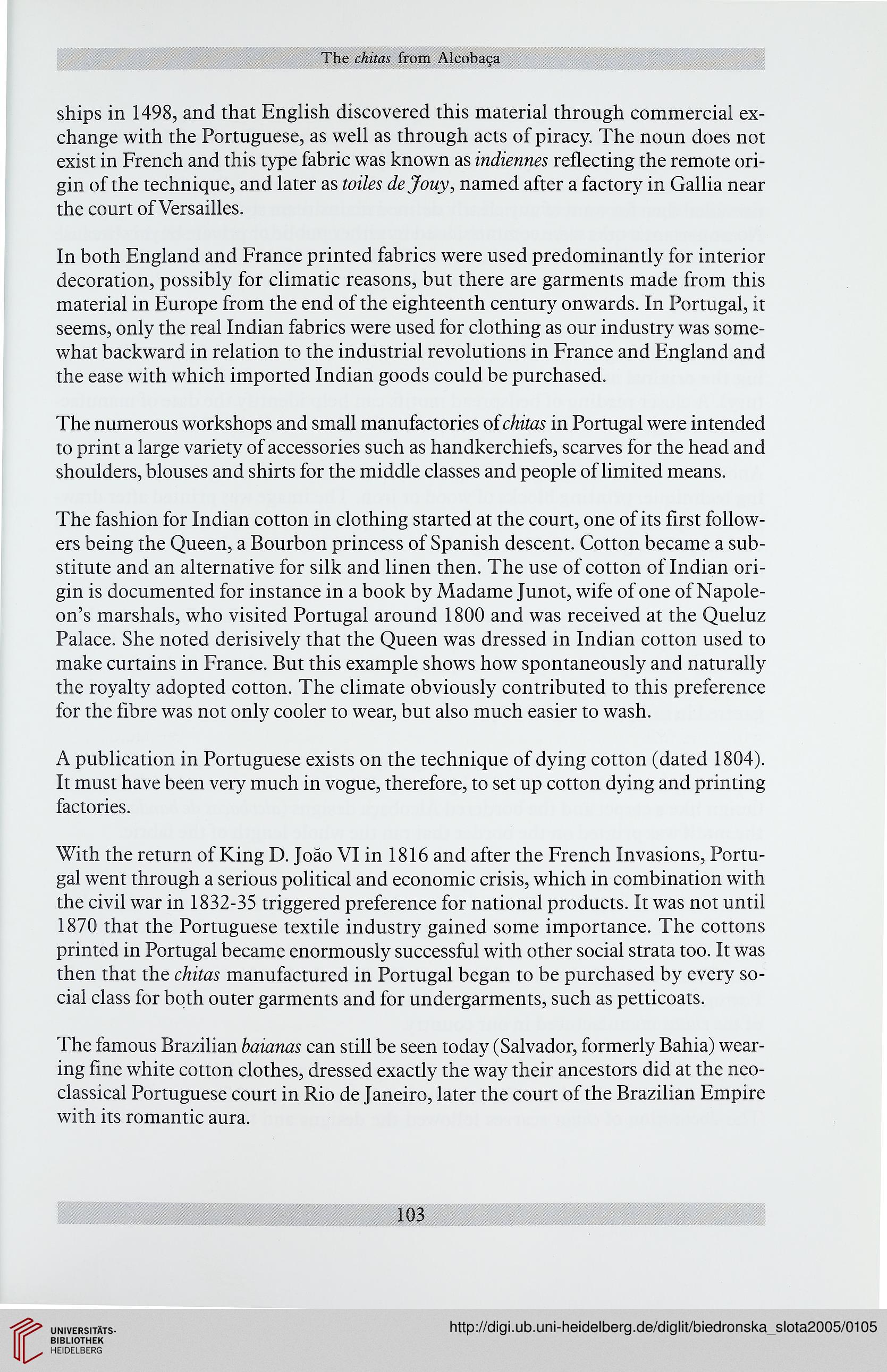The chitas from Alcobaęa
ships in 1498, and that English discovered this materiał through commercial ex-
change with the Portuguese, as well as through acts of piracy. The noun does not
exist in French and this type fabric was known as indiennes reflecting the remote ori-
gin of the techniąue, and later as toiles dejouy, named after a factory in Gallia near
the court of Versailles.
In both England and France printed fabrics were used predominantly for interior
decoration, possibly for climatic reasons, but there are garments made from this
materiał in Europę from the end of the eighteenth century onwards. In Portugal, it
seems, only the real Indian fabrics were used for clothing as our industry was some-
what backward in relation to the industrial revolutions in France and England and
the ease with which imported Indian goods could be purchased.
The numerous workshops and smali manufactories of chitas in Portugal were intended
to print a large variety of accessories such as handkerchiefs, scarves for the head and
shoulders, blouses and shirts for the middle classes and people of limited means.
The fashion for Indian cotton in clothing started at the court, one of its first follow-
ers being the Queen, a Bourbon princess of Spanish descent. Cotton became a sub-
stitute and an alternative for silk and linen then. The use of cotton of Indian ori-
gin is documented for instance in a book by Madame Junot, wife of one of Napole-
on^ marshals, who visited Portugal around 1800 and was received at the Queluz
Palące. She noted derisively that the Queen was dressed in Indian cotton used to
make curtains in France. But this example shows how spontaneously and naturally
the royalty adopted cotton. The climate obviously contributed to this preference
for the fibrę was not only cooler to wear, but also much easier to wash.
A publication in Portuguese exists on the techniąue of dying cotton (dated 1804).
It must have been very much in vogue, therefore, to set up cotton dying and printing
factories.
With the return of King D. Joao VI in 1816 and after the French Invasions, Portu-
gal went through a serious political and economic crisis, which in combination with
the civil war in 1832-35 triggered preference for national products. It was not until
1870 that the Portuguese textile industry gained some importance. The cottons
printed in Portugal became enormously successful with other social strata too. It was
then that the chitas manufactured in Portugal began to be purchased by every so-
cial class for both outer garments and for undergarments, such as petticoats.
The famous Brazilian baianas can still be seen today (Salvador, formerly Bahia) wear-
ing fine white cotton clothes, dressed exactly the way their ancestors did at the neo-
classical Portuguese court in Rio de Janeiro, later the court of the Brazilian Empire
with its romantic aura.
103
ships in 1498, and that English discovered this materiał through commercial ex-
change with the Portuguese, as well as through acts of piracy. The noun does not
exist in French and this type fabric was known as indiennes reflecting the remote ori-
gin of the techniąue, and later as toiles dejouy, named after a factory in Gallia near
the court of Versailles.
In both England and France printed fabrics were used predominantly for interior
decoration, possibly for climatic reasons, but there are garments made from this
materiał in Europę from the end of the eighteenth century onwards. In Portugal, it
seems, only the real Indian fabrics were used for clothing as our industry was some-
what backward in relation to the industrial revolutions in France and England and
the ease with which imported Indian goods could be purchased.
The numerous workshops and smali manufactories of chitas in Portugal were intended
to print a large variety of accessories such as handkerchiefs, scarves for the head and
shoulders, blouses and shirts for the middle classes and people of limited means.
The fashion for Indian cotton in clothing started at the court, one of its first follow-
ers being the Queen, a Bourbon princess of Spanish descent. Cotton became a sub-
stitute and an alternative for silk and linen then. The use of cotton of Indian ori-
gin is documented for instance in a book by Madame Junot, wife of one of Napole-
on^ marshals, who visited Portugal around 1800 and was received at the Queluz
Palące. She noted derisively that the Queen was dressed in Indian cotton used to
make curtains in France. But this example shows how spontaneously and naturally
the royalty adopted cotton. The climate obviously contributed to this preference
for the fibrę was not only cooler to wear, but also much easier to wash.
A publication in Portuguese exists on the techniąue of dying cotton (dated 1804).
It must have been very much in vogue, therefore, to set up cotton dying and printing
factories.
With the return of King D. Joao VI in 1816 and after the French Invasions, Portu-
gal went through a serious political and economic crisis, which in combination with
the civil war in 1832-35 triggered preference for national products. It was not until
1870 that the Portuguese textile industry gained some importance. The cottons
printed in Portugal became enormously successful with other social strata too. It was
then that the chitas manufactured in Portugal began to be purchased by every so-
cial class for both outer garments and for undergarments, such as petticoats.
The famous Brazilian baianas can still be seen today (Salvador, formerly Bahia) wear-
ing fine white cotton clothes, dressed exactly the way their ancestors did at the neo-
classical Portuguese court in Rio de Janeiro, later the court of the Brazilian Empire
with its romantic aura.
103




